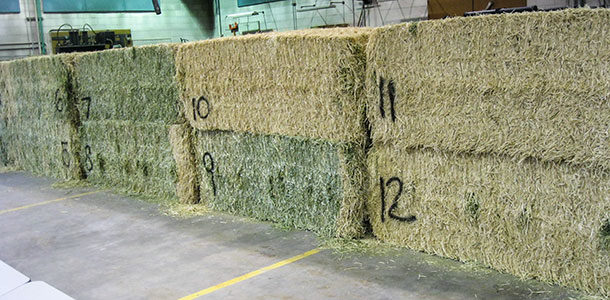“I haven’t been in hay production very long, and I just wanted to learn,” he said.
That’s what brought Neibaur to the 2014 Southeastern Idaho Forage Seminar on March 20. Topics ranged from pest management to undergraduate studies conducted at BYU-Idaho on root nodulation in alfalfa.
A hay grading contest and a quiz about forage pests added an element of fun for the approximately 125 local farmers and students that attended.
Neibaur said he learned some valuable information from a presentation by Dr. Howard Neibling, an irrigation specialist from the University of Idaho. Neibling’s presentation focused on efficient irrigation management, particularly system maintenance.
“It’s not exciting, but it’s important,” Neibling said.

Neibling described a study he was involved with where they observed 30 wheel lines and 30 pivots in the Magic Valley in Idaho. The average for excess water that was pumped into the wheel lines was 25 percent, with 12 percent lost from leaks and 13 percent lost due to worn out nozzles or nozzles that were the wrong size.
“The leaks were primarily old gaskets that were leaking,” Neibling said.
Other fixable leaks that Neibling saw were punctures in the pipes, leaky drain valves and worn out sprinkler heads.
Of the pivots he tested, 60 percent measured lower in system uniformity than industry standards because the sprinkler package needed to be replaced.
“Another thing that seems like it ought to go without saying, but I’ve seen and heard about nozzles being installed in the wrong place on the system and then I’ve seen it on measured data from several of the pivots that the nozzles were in the wrong place.
If you happen to put the nozzles in the wrong place, you’ve got circles that are either over or under watering,” Neibling said.
He suggested using the pivot chart that the supplier gives the grower when replacing a new sprinkler package, and walking down the pivot to make sure that each nozzle is in the correct place.
“I have pictures of several systems that I flew over years ago on the way to Salt Lake that obviously had nozzles in the wrong place. And now, with Google Earth so easily usable, you can find those everywhere,” Neibling said.
Correct tire pressure is another overlooked aspect of pivot maintenance. Having correct tire pressure can reduce deep ruts in the field and the occurrence of breakdowns.
“If the tire pressure is too low, it’s going to put extra loading on the drive motor and the gear box that drives that tower, and so it’s going to wear out sooner,” he said. “And it may die on you in the middle of the hottest day in the summer.”
James Gneiting of Lewisville, Idaho, has been coming to the seminar for 18 years. One presentation he said he learned from was given by Dr. Greg Blaser, an agronomy professor at BYU-Idaho.
Blaser showed the group a “disease triangle” that included a host, a pathogen and the environment. “You always have a host, and you usually have a pathogen. But unless you have the environment, you don’t have a disease,” he said.
Blaser covered many basic diseases, their symptoms and what causes them, followed by a list of ways to prevent disease, such as crop rotation and leaving reserves in the roots after each cutting.
“The main reason we do this is for the students [at BYU-Idaho] to present stuff. It’s good for students to make contact with the industry and with businesses. It also gives people an opportunity to see what’s happening in the industry,” said Blaser, one of the organizers of the event.
Out of the 11 presentations that day, four of the speakers were students from BYU-Idaho who were involved in studies on alfalfa. Nathan Firth, a junior studying agronomy, spoke about an alfalfa seeding rate study that he became involved with a year ago.
In the study, they used a drill to seed plots with rates ranging from 2.5 to 30 pounds per acre. They then measured population and yield within each plot. Surprisingly, they didn’t find a significant increase for either with seeding rates over 10 pounds per acre.
But, as Firth added, the study is only in its second year, and so there will be more data to come. FG
PHOTOS
Top: Hay bales wait to be graded for a contest at the Southeastern Idaho Forage Seminar.
Bottom: The seminar was an opportunity for businesses to market services and products. Photos by Alisa Anderson Raty.












